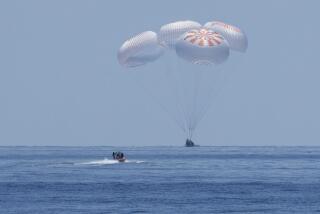NASA Names Sites on Mars Where Rovers Will Land
- Share via
NASA on Friday unveiled the landing sites where it hopes to land twin rovers on Mars in January to look for geological evidence that the Red Planet was once a warmer, wetter place hospitable to life.
Data gathered from NASA satellites orbiting the planet suggest both sites once abounded in water.
One is a crater into which a now-dry river apparently once emptied, perhaps turning the basin into a brimming lake. The other is a plain rich in hematite, an iron mineral that typically forms in standing water.
The sites, both near the equator in the southern hemisphere of Mars, are halfway around the planet from each other. They are each 60 to 120 miles long and roughly 12 miles wide.
“They aren’t the safest sites, they aren’t the riskiest sites, they are the best sites,” said Steve Squyres, a Cornell University geologist and principal investigator for the instruments the rovers carry.
Scientists are confident the scientific tools carried by the $800-million pair of rovers will enable them to operate as robotic field geologists.
The landing sites, Gusev crater and Meridiani Planum, have been studied more closely than any other spots on Mars.






